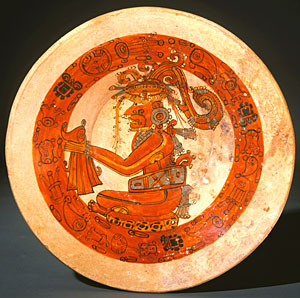
| A photograph of this vessel graced the front of the arts section of the New York Times on June 16, 2006. (more info) |
![]()
|
The opening of "Treasures of Sacred Maya Kings" at New York's Metropolitan Museum and its review by New York Times art critic Holland Cotter (2006) serve to remind us just how lucky we are as students of Mesoamerica and the Maya. Anthropologists, art historians, and interested members of the general public, we get to study and appreciate ancient artifacts that are among the great artworks of all time.
Holland Cotter is an insightful critic, particularly when it comes to ancient cultural material. He suspects that the exhibition, which was called "Lords of Creation: The Origins of Sacred Maya Kingship" when it opened in Los Angeles, was retitled by the Metropolitan Museum with "treasures" in the name in order to pull in the crowds that might have bypassed what might have sounded like "an anthropological think-piece." But Cotter begins his review by commending the Met for truth in advertising. Of the many legitimate treasures that he finds on display, two are singled out for immediate discussion. A kneeling figure carved from wood is actually in the Met's permanent collection and did not travel to the Los Angeles and Dallas venues of the show. Thus it can be contemplated on any trip to New York City and marveled over as much for its own exquisiteness—Cotter holds that "Donatello or Tilman Riemenschneider would have loved it"— as for what it conjures up of other such Maya or Olmec achievements that failed to survive the tropical climate. In Cotter's view, the Dazzler Vase is clearly worthy of its name. On the other hand, not all of the objects in the show are deemed beautiful, let alone masterpieces, and Cotter considers some of them—like a jade model of a bloodletter—to be positively strange.
Whereas a treasures show, in Cotter's formulation, makes about as many demands on the viewer as a window-shopping excursion, the present exhibition feels more like a tour of an archaeological dig (and a recent one at that, considering the number of objects in the show traveling for the first time from Belize, Guatemala, Honduras, and Mexico). The question is what these objects add up to. "You have to do some work, some sorting, sifting and piecing together to get your bearings." Cotter credits the exhibition's catalog, by Virginia M. Fields and Dorie Reents-Budet (2005), with helping the informed museum visitor to get those bearings and begin to understand the story and the history that Fields and Reents-Budet as the exhibition's curators are engaged in exploring. He also cites "Thinking With Things: Towards a New Vision of Art," a new book by Esther Pasztory (2005), as being particularly helpful. It turns out that Cotter worked with Pasztory as a graduate assistant when the book was beginning to take shape around its central premise:
From this perspective, the Maya exhibition is transformed from a treasures show into something more: "a speculative study, through objects, of how political power developed in that culture and what it said about the Mayan's [sic] approach to the world." Cotter recognizes the venerable precedent for Maya kingship in an Olmec figurine's trefoil emblem of the Maize God. Clearly the critic has taken the trouble to inform himself that the Maya "Jester God" derives from the Olmec, as Virginia Fields (1986) first demonstrated. Cotter also notes the trefoil atop the monarch who is depicted on Kaminaljuyu Stela 11 as a "fantastic hybrid of bird and tree," and he asks, "Are we meant to take this as an image of a costumed ceremony or as a supernatural vision? Either way, it turns the figure of the king into a magical abstraction, a living pictograph, an awesome piece of spiritual machinery." While the extent to which living Maya rulers were perceived as divine is still the subject of investigation, the art critic is in accord with current scholarship in saying that kings were apotheosized after death. And he sees a merger of life and afterlife at the heart of the Maya cosmos. His discussion of a funerary mask from Calakmul penetrates to this essence.
(On a related note, the recent opening in Paris of the Musée du Quai Branly, a museum dedicated to non-Western art, has raised the question of what Maya figurines and African masks can be said to have in common, as well as the larger issue of whether "objects that were not created as art should be presented as art, isolated from their ethnographic context" [Riding 2006].) |
top - home
